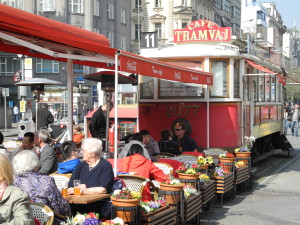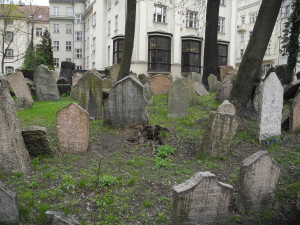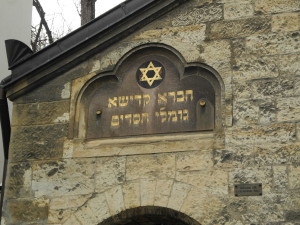For the most part, a visit to Prague is a light-hearted affair: exploring Prague Castle, perusing Old Town Square, sauntering across the Charles Bridge, and perhaps doing some shopping for crystal or dining in a beer hall (more to come on that in a later post).
But the historical attractions are museum-quality relics of long ago, and bizarre incidents — political rivals being tossed out of windows, leading to destructive wars — are ancient history, fascinating but distant. The Habsburg dynasty — which ruled here for nearly 400 years — and the Holy Roman Empire are long gone, leaving us buildings and cathedrals to admire but perhaps less to stir our souls.
But Prague has a more recent past that should stir us to the core, and it bubbles to the surface in the city’s old Jewish Quarter, which is now mostly a monument to inhumanity — namely the Nazi occupation during World War II.
This was brought home by our knowledgeable Insight Vacations guide, Jaroslav, who delivered one of the most chilling lines I’ve ever heard: “Unlike in many other cities, The Nazis spared Prague’s Jewish Quarter because they wanted to preserve it as a museum to an extinct race.” In fact, the Nazis brought items looted from Jews around Europe to Prague to serve as part of this “museum.”
Had I been traveling on my own, I might have skipped a visit to the Jewish Quarter in favor of more time spent in nearby Old Town Square. But after hearing Jaroslav deliver that line, I would not have missed his guided visit there, and — judging from the comments of many of my fellow journalists on the Insight Vacations tour — they felt the same way.
Jewish history in Prague dates back almost to the founding of the city in the 10th century, Jaroslav explained, but after the 13th century the Jews were forced to live in ghettos and wear badges of shame as non-Christians, suffering from oppressive laws and pogroms.
Time brought relief: in the 18th century, Emperor Joseph II, brother of Marie Antoinette, declared Jews to be equal, and now the quarter bears his name: Josefov. Within 100 years they became fully equal under the law — until World War II and the six-year Nazi occupation. (Hitler was awarded Czechoslovakia by the Munich Agreement of 1938.)
Prior to the World War, Jaroslav told us, there were 120,000 Jews living in what was then Czechoslovakia; two thirds of them died during the war, many of starvation in concentration camps. The Czech Republic now has only 6,000 Jews living in 10 communities; many left for Israel after the founding of the Jewish state.
We first visited a 500-year-old synagogue that now serves as a stark memorial to all the Czech Jews who perished in the Holocaust. Reminiscent of the Vietnam War Memorial in Washington, DC, the names of thousands of victims are inscribed on the walls, covering several rooms. Organized by their villages and last names, they are a haunting reminder that mass-scale genocide flourished in the mid-20th century, just shortly before the earliest members of the baby boom generation were born.
We next toured a Jewish cemetery containing 12,000 gravestones, but many more bodies than that are believed to rest here. Burials took place between 1439 and 1789, when Jews were confined to the ghetto.
Of the six remaining synagogues in Prague, Jaroslav led us to the 13th-century “Old New” Synagogue — the oldest in the world outside Israel — which is still in use, and the Spanish Synagogue, so-called because of its beautifully decorated Spanish-Moorish style. Various museum visits featured Jewish religious and artistic items brought here for display by the Nazis, among other exhibits. (Much of the area, in fact, is now known as the Jewish Museum — but not what the Nazis had in mind.)
Prague’s problems didn’t end with the war. The city was liberated from the Nazis by the Soviets in 1945, who then imposed communism on all of Czechoslovakia — including suppressing the anti-communist revolt known as the “Prague Spring of 1968” — until the bloodless Velvet Revolution of 1989, when the country was finally free of outside domination.

A colorful cafe in Prague’s Wenceslas Square, where demonstrations against the Soviets once took place. Photo by Clark Norton
Czechoslovakia was split up into the separate nations of the Czech Republic and Slovakia in 1993 — undergoing a kind of friendly “velvet divorce,” as Jaroslav put it — with Prague serving as capital of the Czech Republic. The country joined NATO in 1999 and the European Union in 2004, though it kept its own currency, the crown (korun).
That’s just a brief summary of the historical background briefing we received from Jaroslav — one of three brothers, all of whom are local guides — and our tour director, Neira Milkovic, who hails from Croatia but has been leading Insight Vacations tours in Central Europe for years, and knows the territory intimately.
These are hard lessons from the not-too-distant past, but they serve to underline the sheer beauty and yes, light-hearted spirit that you sense in Prague and the Czech Republic today. The country hasn’t suffered the same level of economic woes that have plagued several other European countries in recent years, and, according to Neira, Czechoslovakia’s economy also weathered the communist years better than most eastern bloc countries.
Insight Vacations, I learned, is an appropriate name for a company that takes its responsibility to offer insights into the culture and politics of the countries it visits very seriously indeed.
Next up: Why the Czech Republic is the beer capital of the world, and what and where to eat with your brew.














4 Responses to Insights Into Prague’s Sometimes Troubled Past